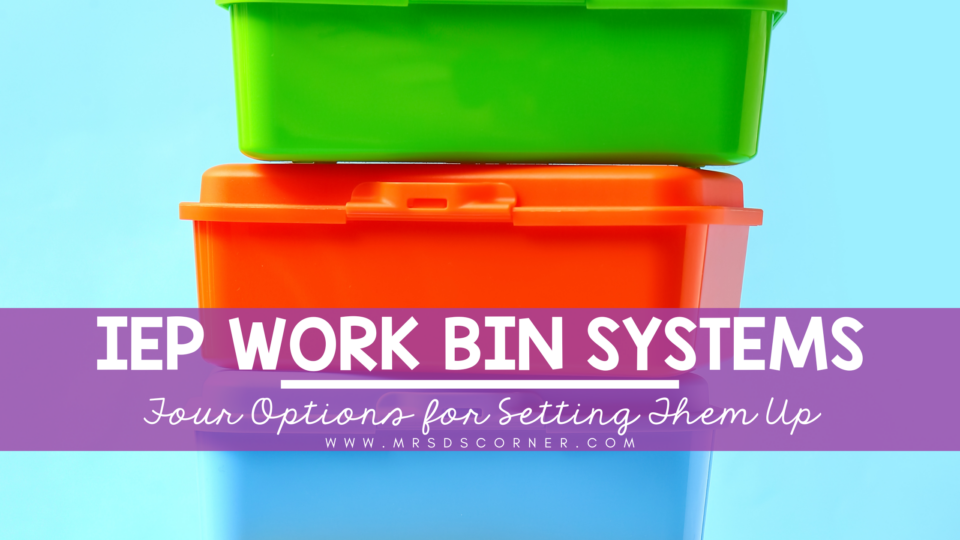In the world of special education, Individualized Education Programs (IEPs) play a crucial role in helping students with disabilities achieve their academic goals. However, implementing and managing IEP goals can be a challenging task for teachers. That’s where an IEP work bin system comes in.


In this blog post, we will explore the concept of IEP work bins, their benefits, and provide teachers with several options for setting up a successful system.
What are IEP Work Bins?
IEP work bins are individualized learning stations or containers that hold materials and activities designed to target specific IEP goals. These bins are organized according to each student’s unique needs and serve as a structured framework for students to practice and reinforce their IEP goals.
There are a lot of different types of work and resources you can place in IEP work bins. Here are some of our favorite ideas!
The Benefits of IEP Work Bins
Implementing an IEP work bin system offers numerous benefits for both students and teachers:
- Individualization: IEP work bins allow for highly individualized instruction, catering to the specific goals and needs of each student.
- Engagement: By providing hands-on and interactive activities, IEP work bins enhance student engagement and make learning more enjoyable.
- Independence: Students can work at their own pace and take ownership of their learning, fostering independence and self-confidence.
- Organization: IEP work bins promote organizational skills as students learn to manage their materials and complete tasks within a designated space.
- Data Collection: With materials and activities readily available in the bins, teachers can easily collect data on student progress and track their achievements.
Now that we understand the benefits let’s explore some practical options for setting up an effective IEP work bin system.
Option 1: Name-Based Bins
One approach is to create individual bins labeled with each student’s name. Within these bins, teachers can include 3-4 activities aligned with the student’s IEP goals. This option allows for easy identification and personalization of materials for each student.
Consider including a file folder activity, manipulative activities (such as puzzles or sorting activities), picture cards, and more. This variety ensures a diverse range of learning experiences and keeps students engaged.
Option 2: Goal-Based Bins
Another option is to organize the work bins based on specific IEP goals. Each bin is dedicated to a particular skill or objective, such as reading comprehension, math calculations, or social skills. This approach streamlines the materials and activities according to the targeted goals.
Use bins with multiple compartments and sections. This allows for easy organization of files, data sheets, and related materials for each goal. Additionally, including the students’ preferred fidgets and reinforcers in the bins will create a positive learning environment and help them stay on task.
Option 3: Color-Coded Bins
For visual learners and teachers seeking a more visually organized system, color-coded bins can be a great choice. Assigning a specific color to each student or goal allows for quick identification and differentiation.
Try using color-coded bins paired with binders containing data collection sheets and dividers for each student. This approach facilitates easy access to student progress data during IEP meetings or when reviewing goals.
Color-coding is also one of our favorite approaches to any classroom because it makes it so easy to keep things organized. Here are some more tips for organizing the classroom and keeping bins and resources tidy!
Option 4: Hybrid Approach
Teachers can also adopt a hybrid approach by combining elements from the previous options. This approach provides flexibility and customization based on individual student needs and available resources.
You might also want to use basic task boxes/file folders/basic skills at the para table while maintaining an organized teacher table system that allows you to address students’ goals more thoroughly. This hybrid approach allows for differentiated instruction while ensuring an effective teacher-student interaction at the teacher’s table.
If you need more ideas for making IEP work bins, this video can help:
Remember, no one-size-fits-all solution exists when it comes to setting up an IEP work bin system. Teachers should consider their students’ needs, available resources, and their own teaching style when choosing an approach.
An IEP work bin system is a powerful tool for helping students practice their IEP goals. By implementing this structured and personalized approach, teachers can foster independence, engagement, and organization while supporting each student’s unique learning journey. Whether using name-based bins, goal-based bins, color-coded bins, or a hybrid approach, teachers have multiple options to create an effective and efficient IEP work bin system.

